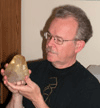| View previous topic :: View next topic |
| Author |
Message |
Tom Mazanec
Joined: 11 Feb 2016
Posts: 139
Location: Twinsburg, Ohio


|
 Posted: Oct 27, 2016 13:00 Post subject: Do people still use chemistry and fusibility? Posted: Oct 27, 2016 13:00 Post subject: Do people still use chemistry and fusibility? |
|
|
| I was just skimming through my Kindle copy of F. H. Hatch's Mineralogy (1912) and noticed that a lot of mineral descriptions have things like "turns gelatinous in aqua regia and dissolves in hydrochloric acid". It also has a scale of fusibility (6 levels plus "infusible"). I don't see this in my contemporary mineral books in my library. Have they gone out of use? If so, why? |
|
| Back to top |
|
 |
Pete Richards
Site Admin

Joined: 29 Dec 2008
Posts: 846
Location: Northeast Ohio



|
 Posted: Oct 27, 2016 13:21 Post subject: Re: Do people still use chemistry and fusibility? Posted: Oct 27, 2016 13:21 Post subject: Re: Do people still use chemistry and fusibility? |
|
|
These observations still provide useful information, especially when one does not have access to high-tech equipment like X-ray diffractometers and scanning electron microscopes. The problem is that they are qualitative, or if "quantitative", the determination of degree (of fusibility, for example) is quite subjective until one has a great deal of experience. To use another example, borax beads will reveal the presence of certain elements by producing a color when fragments of a mineral are dissolved in a borax flux under a blowpipe flame. The test will tell you if element x is present, but not how much. It may be present but non-essential - i.e. not part of the formula of the ideal mineral.
Some of these tests are particularly useful in a negative sense: if you think you have a specimen of strontianite but cannot get the characteristic red flame color, you'd better consider that it might be aragonite instead.
These tests are particularly useful as pieces of a toolkit that also includes hardness and other physical properties, geometric properties (crystal morphology), and especially optical properties, challenging though they are to master. When used together in a weight-of-evidence manner, they can allow identification of many minerals. They probably are not taught in most mineralogy classes these days, but they should be!
_________________
Collecting and studying crystals with interesting habits, twinning, and epitaxy |
|
| Back to top |
|
 |
Cesar M. Salvan
Site Admin
Joined: 09 Jun 2008
Posts: 127
Location: Alcalá de Henares



|
 Posted: Oct 28, 2016 11:39 Post subject: Re: Do people still use chemistry and fusibility? Posted: Oct 28, 2016 11:39 Post subject: Re: Do people still use chemistry and fusibility? |
|
|
| Tom Mazanec wrote: | | I was just skimming through my Kindle copy of F. H. Hatch's Mineralogy (1912) and noticed that a lot of mineral descriptions have things like "turns gelatinous in aqua regia and dissolves in hydrochloric acid". It also has a scale of fusibility (6 levels plus "infusible"). I don't see this in my contemporary mineral books in my library. Have they gone out of use? If so, why? |
All is chemistry. Spectrometry is also chemistry and the classic chemical assays are obviously useful: chemistry is always right, was right in the XIX century and now. Why you should see this in contemporary mineral books if we already have a huge bibliography on the topic?.
The classic assays are still in use. Some are very useful on the field or for getting a fast answer. I particularly use a lot of "old school" assays to save time, especially microchemical assays. But it is also true that a lot of classic assays are now obsolete, as others replaced it. For example, in the 1920-1930 years, the chemical microscopy and microchemistry were very well developed and made unnecessary some assays from older books and the chemical microscopy were widely used by geologists, mineralogists and chemists, together with the petrographic microscope, until the development of practical and accesible spectroscopic instrumentation as microprobe, SEM-EDS and Raman. The modern spectroscopy turns chemical microscopy obsolete for papers and so, but it is still useful in daily practice (although soon will be a lost art).
"Some of these tests are particularly useful in a negative sense: if you think you have a specimen of strontianite but cannot get the characteristic red flame color, you'd better consider that it might be aragonite instead. "
I am not completely agree with that. Remember the golden rule "absence of evidence is not evidence of the absence". I never use a negative result as a proof per se. A negative result could be useful together with other results, but not alone. The example of strontianite and aragonite is a good example. Ca and Sr both impart a red color to the flame, but with a different tone (Ca orange-red and Sr crimson red). In some cases (for example, Sr-bearing calcium carbonate) is really difficult to distinguish. Also, the color depends on the temperature of the flame, maybe the person who perform the test do something wrong and/or do not see a clear result or no result at all, maybe there are some interference (for example sodium and its strong yellow color could be observed with very small quantities). On the other hand, an unambiguous color at the flame test is a good evidence in some cases of the presence of the element (the word unambiguous could convert the analysis in a nightmare). Overall, the negative tests should be used with caution. |
|
| Back to top |
|
 |
|





